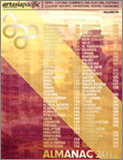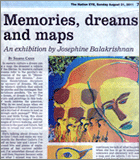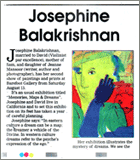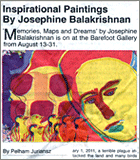![]()
Memories, Maps & Dreams
'Games We Play' with vibrant shades
Ruwini Jayawardana
Daily News Sri Lanka
August 26, 2008
The title itself has a strange note that grips your attention. 'The Games We Play…Under the Coconut Trees' sends you back to a time when you were carefree and ready to enjoy a game of cards or board games.
Infused with tropical pop bravado of South Asian and Californian sensibility, these paintings are the recollections of thoughts that Josephine Balakrishnan had in her childhood when she used popular children's games to combine with imagination to make up stories.
Her work explores the emotions and consequences the games have on children, how they teach them to take risks, barter and communicate while winning and losing relationships. It is all blended with our personality for the reactions and choices reflect what we are.
'Games We Play' is a compilation of around 28 paintings by Balakrishnan on exhibit at the Barefoot Gallery till September 7.
Born in England, Balakrishnan had spent the latter part of her life on the move. She had visited many parts of the world, Asia, Europe and South America before finally settling down in Central California, North America.
The tales that her mother would relate to them about her ancestors in Sri Lanka fascinated the young girl and encouraged her power of imagination. Hailing from a family of artists, she had taken up the brush at an early age and express her thoughts to others by transmuting the images of her mind to colourful sketches on canvas.
Her work is made up of symbols, the social backdrop and colour sense taken from her travels in countries like India, Sri Lanka and Europe. She relates that her work often needs a sense of more than one culture to decipher its content.
"There are three aspects to the paintings. One is basically about the games that play like scrabble, monopoly, snakes and ladders, cards and many more.
There is a psychological side to games which involves what we do and react towards each other. Then there is the inner part which of the game which relates a story through symbols and colour," Balakrishnan explained.
One of her stories relates a tale of a man who had come home to find that his wife had all the cupboards open. He had warned her to keep the cupboards locked and once he discovered that she had disobeyed him it was a sign that their relationship was coming to an end.
Josephine had held painting exhibitions at the Barefoot Gallery for more than 20 years. She had also exhibited her work abroad and some of her work had been sold in major museum stores like the National Gallery, Museum of Modern Art New York, Chicago Art Institute, Guggenheim and many more.
"I am doing pretty well and I guess that the Californian colours and the tropical shades in the paintings speak to both communities.
I found a printing medium from which I could keep the intensity of the colours," she said adding that she had been searching for a method to preserve the vibrant shades of her paintings for the past couple of years.
"Painting had always been something that I loved to do and my family had always been very supportive towards enhancing my talent. I have also done sculptures but painting took over once I went to New York.
I have also done printmaking and I hope to venture towards filmmaking. I also have a series of 13 six foot five by five paintings titled 'Pilgrims in the Diaspora' which I hope to launch along with a small audition book," she stated concluding that she aims to inspire others to tell their own stories, to use their own images without imitating others work.
Josephine Balakrishnan: Sufi Chocolate
William Torphy
Fall, 2003
The title of Josephine Balkrishnan's recent exhibits in Colombo, Sri Lanka and in California approximates the rich visual and conceptual dialectics of her tasty, dreamlike paintings. Sufi Chocolate seems a metaphorical substance encompassing great contradictions and contrasts. Balakrishnan's oils and works in resin pigment possess the seductive sensuality of the sensory world (chocolate's attraction) while conceptually derived from an unworldly, Sufi-like "wisdom of the heart."
Born in England and raised in the United States, Balakrishnan comes from a long line of Sri Lankan artists. Her painting clearly reflects her global upbringing and roots. Vivid colors of the tropics stylistically underscore these personal narratives of inner and outer experience. The works elliptically illustrate anecdotes that expansively comment on things universal. The artist's mother narrated elaborate stories of family and friends in Sri Lanka. These and others are explored in paintings such as "Green Stories" (which pictures a female teller of tales surrounded by an all-pervasive viridescence) and "Crying on the Train." They seem to attempt a balance between the specific (material) and the poetic (mystical), somewhat in the manner of a V. S. Naipul story: characters and situations so vividly described that they ultimately transcend their corporal limitations into greater identities.
Reconciling themes of separation and union/cultural and individual identity infuse these paintings. "Heart & Head Embracing" combines apparent male and female images united with an arm upraised in the foreground, beckoning both. "Heart Spoke to the Mind" reveals a dynamic Matisse-like form hovering cerebrally above an illuminated stem touching the heart gently.
These are poetic, thoughtful works dressed in bright "Indian colors." Stylistically, at first glance they might be called "Tropical Pop." But there are no clearly delineated hardened forms or opaque plastic surfaces. Rather images seem transparent and approximate, one form folding into another, then uniting again into even more surprising fusions. Balakrishnan claims the influence among others of Francesco Clemente and Carl Jung, two masters on the slippery slope of interpreting transcultural meaning. But here our interpreter is in the guise of a bindi-wearing guide in a color-saturated world of seeming appearances. The symbolism in these paintings is certainly captivating. They reveal fetching stories the viewer wants to discover, like dark chocolate wrapped in a mysterious bright wrapper.
* * * * *
WILLIAM TORPHY is a West Coast curator and art writer. His articles and reviews have appeared in ARTWEEK, HIGH PERFORMANCE, CROSS CURRENTS and UNSOUND. He has curated over 150 exhibitions in museums, galleries, art associations, alternative spaces and corporate venues. He was Director of the Bay Area-centered Silk Road Project, a transcultural arts collaboration.
Cross-cultural palette; painter Josephine Balakrishnan straddles both Eastern and Western worlds
Marge Speidel
Palo Alto Times
November 21, 2003
Cobras dancing. Men walking on fire. People who vanish and then reappear.
Those are some of the childhood images that helped shape the colorful paintings of Josephine Balakrishnan, whose show opens tonight at Art21 Gallery in Palo Alto.
Balakrishnan lives in Albany, but to call her an East Bay artist — or even a California artist — is a misnomer. In her unique cross-cultural life, she lived on four different continents in her early years.
Balakrishnan's mother is Sri Lankan; her father English. They met through his work in Sri Lanka, were married there and then moved to England, where Balakrishnan was born. For the first four years of her life, the family spent time in Asia, Europe and South America, settling in California when she was 5.
"For a while we changed continents every two years. Then we moved to a small California town, Arroyo Grande, on the coast," Balakrishnan said. "There my mother told me unusual tales of her family, of people who could foretell the future, snakes that danced. As a child, I spent long hours using playing cards to tell myself stories that would help decipher my personal universe."
Coming from a family of artists, Balakrishnan had access to art materials early on, and used them to explore her connection with the rest of the world. At 12, she went to Sri Lanka to study that country's art. She attended UC Berkeley and became a sculptor, studying in New York City. She later switched to painting. Her art has been shown in the U.S. for 25 years and in Sri Lanka for 15.
"This shows the two parts of me," Balakrishnan said. "When I was very young, the English had a practice of placing young babies outside in a pram alone for long periods of time. That experience gave me a sense of isolation that I sometimes feel when I'm in Western culture."
"Sufi Chocolate," the title of her Palo Alto show, refers to the sufis — members of a mystic Muslim sect — who see themselves on the path to the beloved, a direction to the higher source of wisdom within the human heart.
"In my work they represent not so much a specific religion but the concept that what is missing from the divine goes through the heart," the artist said. "The head is not really a part of it. Each painting relates to this. By contrast, chocolate is tangible and sweetens the heart through the body and brain. I call them psychological symbols, the sweetness of chocolate and the need of your soul to connect with the universe."
Balakrishnan works in what she calls visual dissidence — the ability of the human mind to resolve incongruent concepts and materials to reveal meaning. This process mixes cultural and secular symbolism with a visual imagery that embraces both Eastern and Western culture. California images and tropical visions of Sri Lanka reoccur in her works.
A strong colorist, Balakrishnan uses hot pinks, deep aquamarines, browns, reds and greens, defining faces and other details with bold ink strokes. The medium is oil on paper, with pigmented ink on resin.
"When I'm in Sri Lanka and south India, the color palette matches my own internal palette," Balakrishnan said. "I find colors are much more dream-like. Life is more exposed and the inside is literally out — colors, emotions and states of living. In the West, those become my inner palette and I have a drive to express that reality. When I am in the East I have a great desire to do nothing but drink lime juice and look at the environment around me. The colors and sounds are vibrant, as many of my dreams are."
Walking among her paintings as she and her husband unloaded them for the show at ART21, she pointed to a piece called "Dark River," a reference to the Hindu and Native American belief that we receive messages through a third eye in the center of the forehead. The title suggests being in the dark until a message of enlightenment comes.
"Life is But a Dream" expresses the two cultures in which the artist divides her time. One side of the painting shows lush, tropical fruit trees, while the other side depicts a small boat adrift on the water.
Artists abound in Balakrishnan's family. Her mother, who lives in Colombo, Sri Lanka, is a writer with more than 20 published books. (She received a master's degree in English from UC Berkeley and was a Fulbright scholar.) An aunt is also a published writer. Michael Ondaatje, author of the novel, "The English Patient," is a relative (their grandmothers were first cousins). He has written a novel based on her family, which dates its history in Sri Lanka back 250 years. Entitled "Running in the Family," it was published about 1980.
Balakrishnan's husband, Dave, is a composer and violinist with Turtle Island String Quartet, a jazz ensemble. They have been married seven years and have four children from previous marriages.
Part of what has kept Balakrishnan painting is new advances in technology that have allowed her to work rapidly, plus advances in archive color production. She completed the paintings in her show over the past six months, sometimes working on three or four simultaneously.
"I call it electronic imagery," she said. "I paint using a very fast computer and a program called Painter. The process is similar to lithography, where the image is made directly into a plate. In this process prints come off a plate in a similar way. The process differs for each painting."



